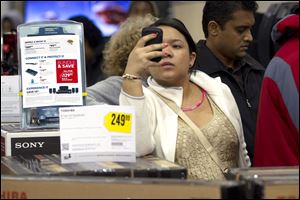
Retailers use social media as guide to merchandise
12/18/2012
A shopper at a Florida Best Buy checks her smart phone. More retailers are plumbing social media sites such as Facebook to learn what their customers want to see on store shelves.
NEW YORK — Facebook isn’t just for goofy pictures and silly chatter. Whether shoppers know it or not, their actions online help dictate what's in stores during this holiday season.
After polling customers on the social media site, Macy’s decided to carry denim jeans in bright neon hues rather than pastels. Wal-Mart Store Inc. for the first time let customers vote on which toys they want discounted. And to better plan orders for the decorative flags she sells, a small-business owner in Mississippi is running a contest that encourages customers to chime in about how they’re decorating their homes this winter.
The impact of social media on a company’s bottom line is tough to quantify, with no hard data on how millions of Facebook Inc. fans and Twitter followers translate into sales for stores. But during the holiday shopping season, stores are uncovering a valuable use for all the seemingly useless online muttering: market research.
The result is that whenever folks press the “like” button to give their seal of approval for a particular company’s page or make a comment on how much they like the leather boots they just bought, they’re helping everyone from independently owned shops to the nation’s biggest retailers make decisions about what products to stock up on, what to play up on the sales floor, and what to promote online.
For the first time this year, one of Macy’s apparel buyers suggested the company solicit feedback on Facebook on which colors it should stock for Else brand jeans in the fall ahead of the holiday shopping season. Several weeks later, “Very Vivid” shades of blue, orange, and red were declared the victors over softer shades such as baby pink and baby blue.
Companies are just realizing the value of making customers feel as though they’re part of the decision-making process, said Jennifer Kasper, who heads digital media at Macy’s. In addition to making customers feel like insiders, she said it helps businesses better tailor their offerings.
One hurdle for major retailers is that it’s difficult to take the information they learn online and put it to use while the trends are still relevant, said Nicolas Franchet, head of retail ecommerce at Facebook.
That’s one of the trickier aspects of Wal-Mart’s new “Toyland Tuesday” contest, which lets fans vote on which of two toys will be discounted on the following Tuesday.
Once a winner is declared on Thursday, the retailer acts quickly to inform its 4,000 stores of how to adjust pricing and displays, said Wanda Young, senior director of social media for Wal-Mart.
Melinda Vitale Shaw, owner of the two gift stores in Picayune, Miss., is using Facebook as a sounding board for what to stock in her stores. Ms. Vitale Shaw recently asked fans to post about the flag designs they were flying or what they wished they were flying.
She was surprised to see comments about snowman flags because it doesn’t snow much in the South. She called Facebook “a true retailer’s friend.”
Outdoor retailer Gander Mountain is handing the reins over to fans on social media. Every Thursday, the chain, based in St. Paul, runs a promotion that lets customers push down the price on five selected items by sharing them on Facebook or Twitter.